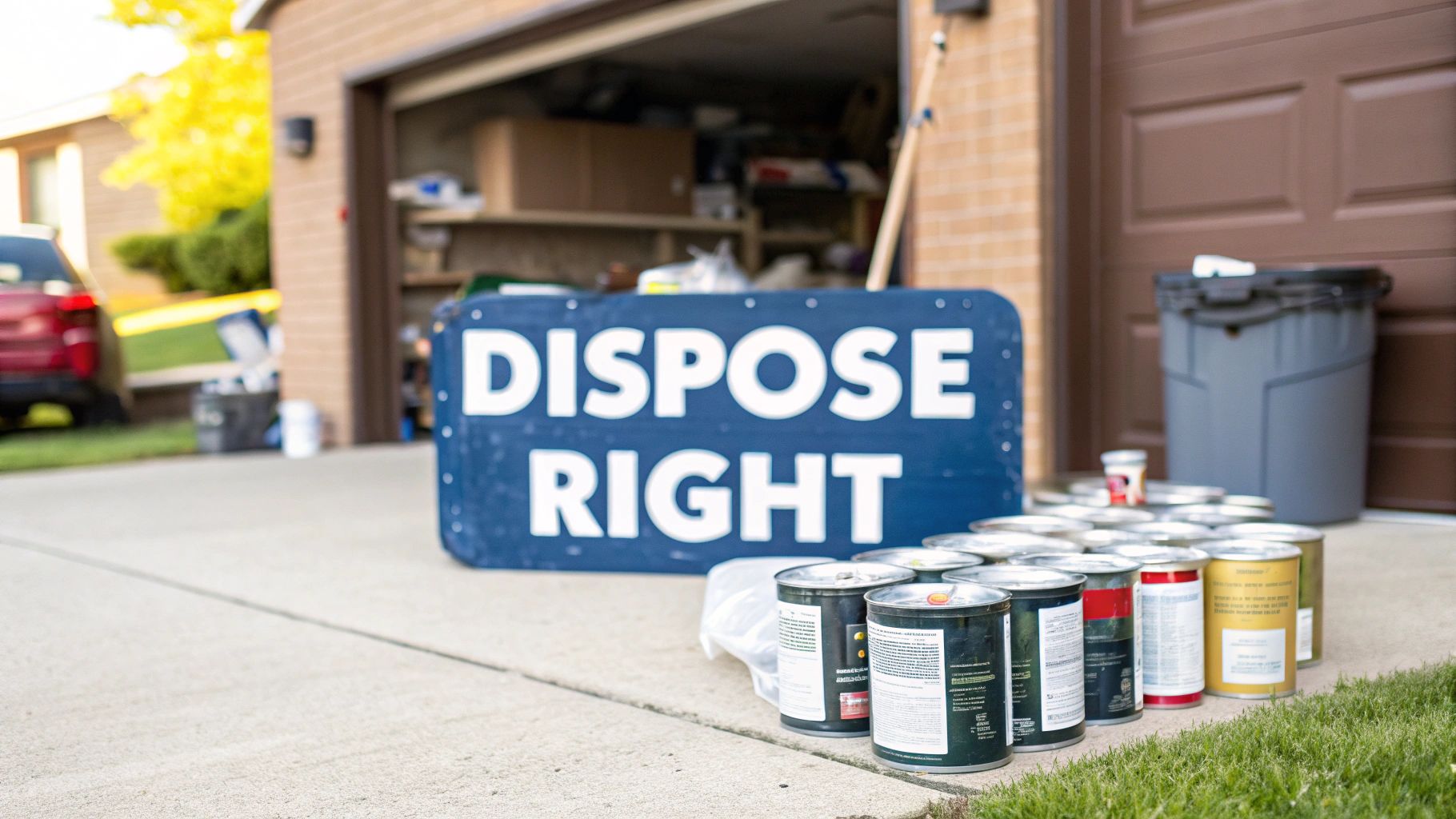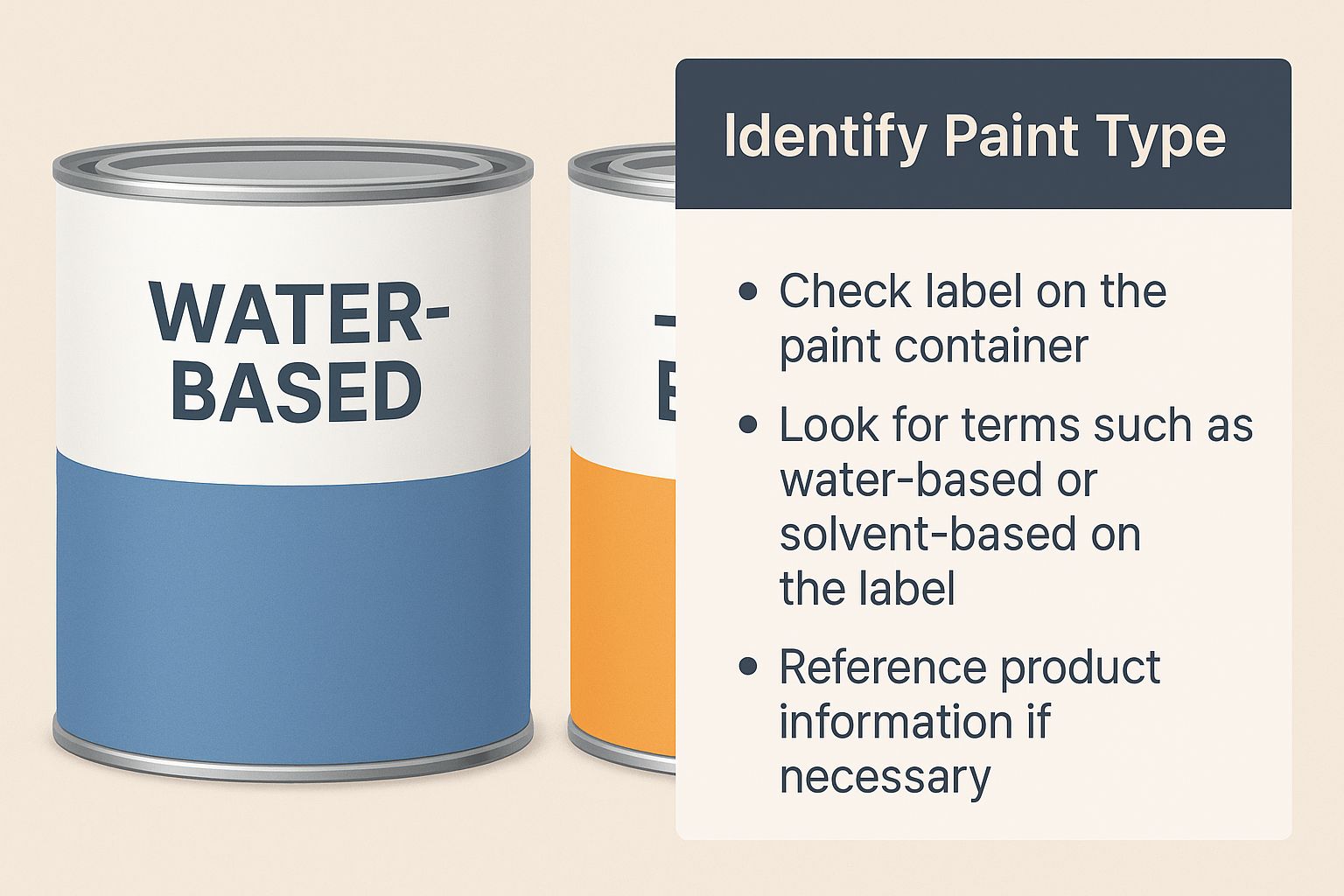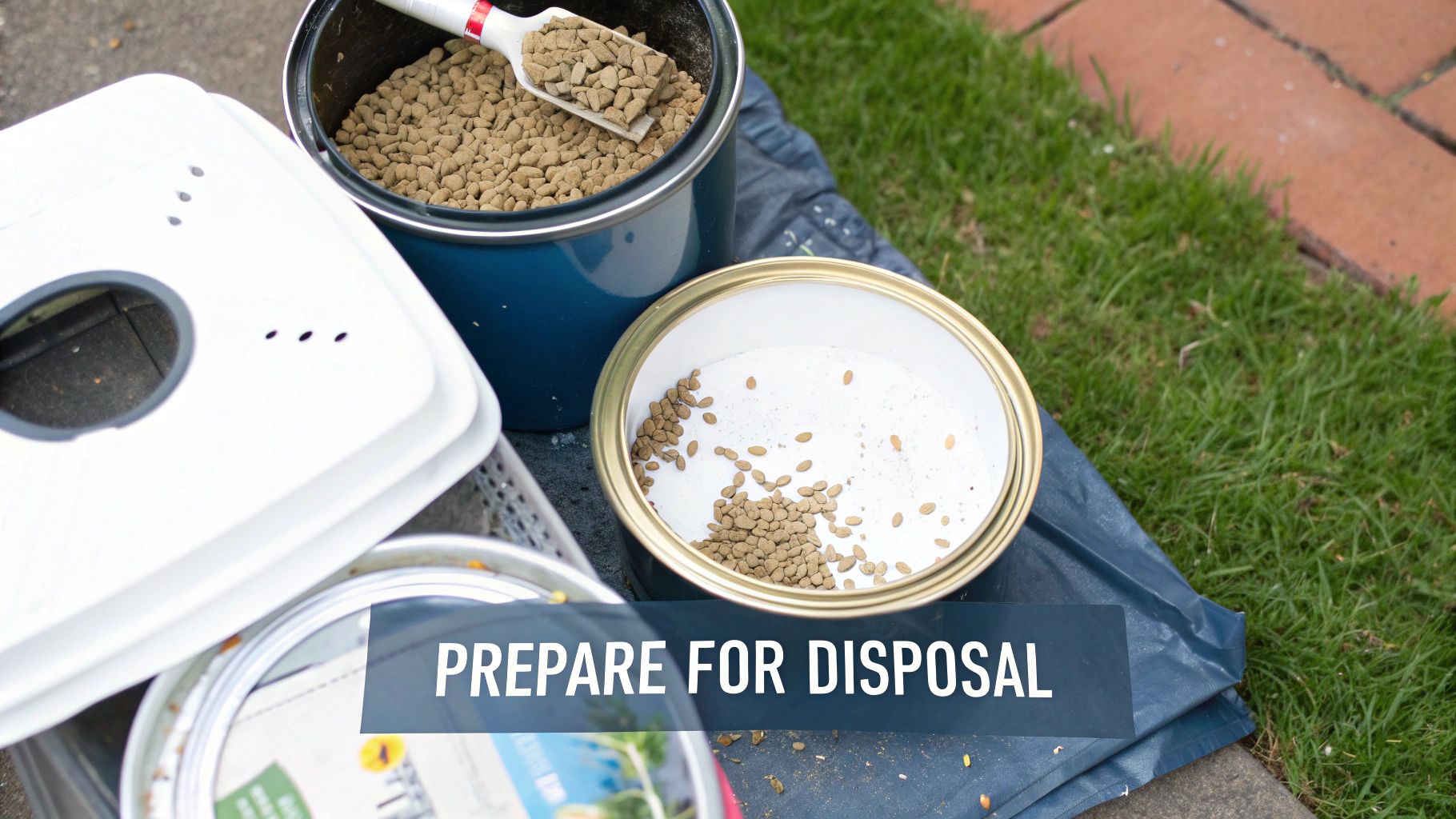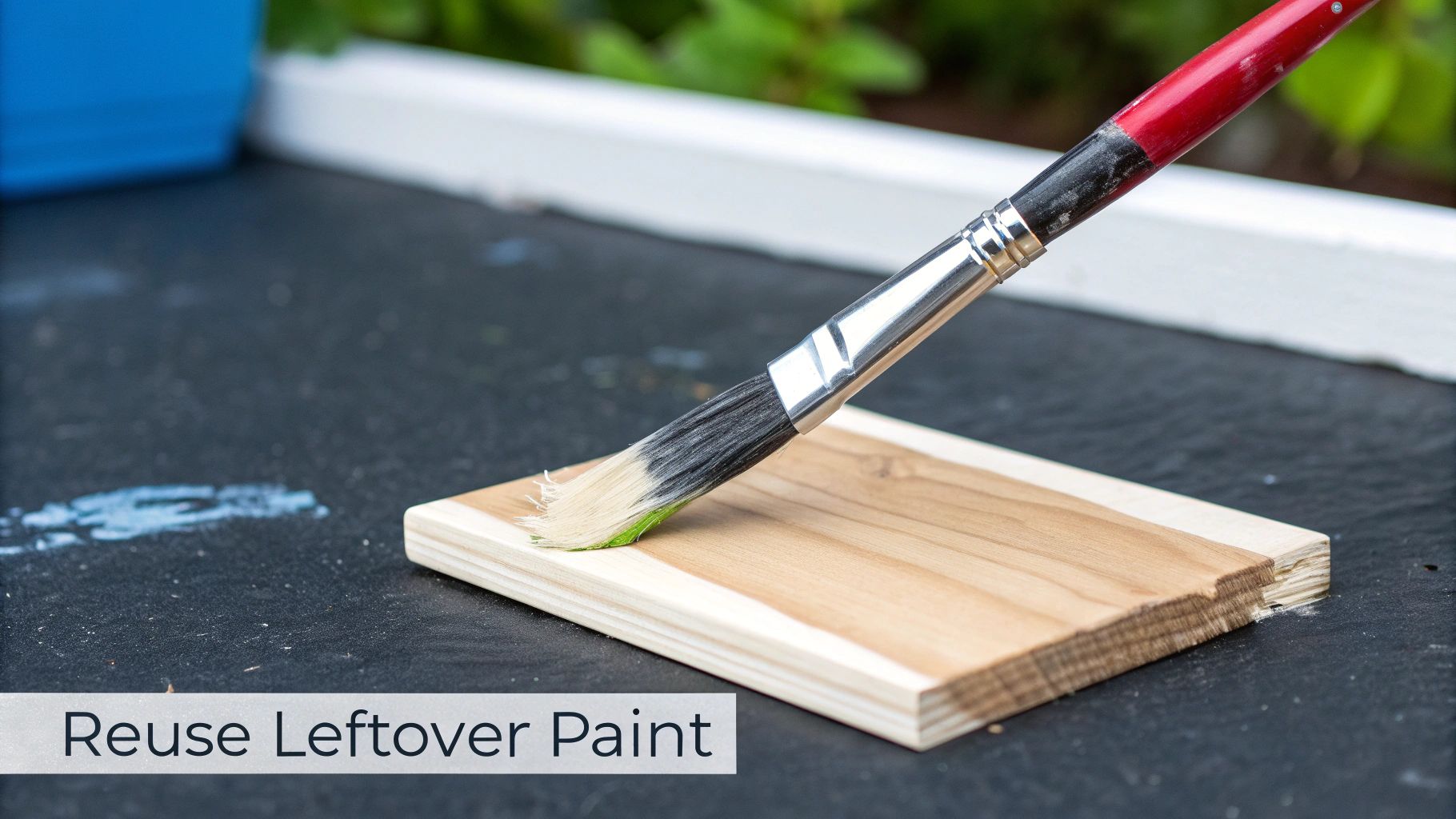How to Dispose of Old Paint Tins the Right Way

How to Dispose of Old Paint Tins the Right Way
Before we dive into the how of getting rid of old paint tins, it’s really important to get your head around why you can’t just chuck them in your household bin. It might seem like the easiest option, but improper disposal is a serious environmental problem and can even get you in trouble with your local council.
Why? Because paint is usually classed as hazardous waste, all thanks to the chemicals inside. While empty, fully dried metal tins can sometimes go in with your general rubbish, any tin with liquid paint left in it needs a completely different approach.
The Environmental and Legal Reasons for Proper Paint Disposal
That half-full tin of emulsion gathering dust in the garage is more than just clutter; it’s a potential environmental hazard. If it ends up in a landfill, those chemicals can slowly leach out, seeping into the soil and making their way into our groundwater. The solvents, pigments, and binders in paint simply don't belong in natural ecosystems.
Pouring it down the drain is even worse. It’s a fast track to polluting our waterways, as it can mess up the water treatment process and harm fish and other aquatic life. This is precisely why there are strict rules in place. To get a better grasp of the wider rules, it’s worth reading our guide on hazardous waste disposal regulations.
The Scale of the UK's Paint Waste Problem
This isn't just about your one tin. It's a massive, collective issue. The British Coatings Federation has revealed a truly eye-watering statistic: an estimated 34 million litres of decorative paint are left over in UK homes and businesses every single year.
What’s shocking is that a reported 98% of this leftover paint is either dumped in landfills, incinerated, or poured down the drain. None of these are sustainable solutions. The industry is trying to tackle this through initiatives like PaintCare, which is a great step forward.
This graphic from their website shows exactly where all that paint ends up.
It’s a powerful visual, isn't it? It hammers home just how much of a problem this is and how little is currently being reused or recycled properly.
What Makes Paint a Hazardous Material?
The need for careful disposal all comes down to what’s actually in the paint. The ingredients vary, and many of them are pretty nasty for the environment.
- Solvent-Based Paints: These are often packed with volatile organic compounds (VOCs), which are bad for air quality and aren't great for our health either.
- Older Paints (Pre-1970s): If you've got some really old tins, there's a chance they could contain lead. This is a highly toxic heavy metal that needs specialist handling.
- Additives and Pigments: Things like fungicides, biocides, and certain colour pigments can be toxic to wildlife and hang around in the environment for a very long time.
The best approach is to treat every tin of paint as potentially hazardous until you know for sure. It’s a simple mindset shift, but it’s the most responsible way to protect your local environment and stay on the right side of the rules.
Once you understand why it matters, the process of sorting it out becomes less of a chore and more of a positive action. Knowing the risks makes following the correct steps feel much more worthwhile.
First Things First: Identifying Your Paint Type
Before you even think about getting rid of those old paint tins, you’ve got to play detective. The single most important factor is figuring out what kind of paint you're dealing with, as this decides whether it’s treated as simple household waste or something more hazardous.
Paints generally fall into two camps: water-based (like most emulsions) and solvent-based (your gloss or satinwood paints).
Getting this right is absolutely crucial. Why? Because their disposal routes are worlds apart. Water-based paint, once it’s completely dry, is generally considered non-hazardous. Solvent-based paint, however, is a different beast entirely and must be handled as hazardous waste due to its chemical makeup.
So, how can you tell them apart? The easiest way is to just read the tin.
- Water-Based Paint: Look for clues like "water-based," "latex," or "acrylic." The cleaning instructions are another dead giveaway – if it says to clean brushes with soap and water, you're golden.
- Solvent-Based Paint: These tins will often be labelled "oil-based," "alkyd," or "enamel." If the cleaning instructions mention needing white spirit or another solvent, that’s your answer right there.
No Label? No Problem
What if the label is caked in dried paint or peeled off years ago? Don't panic. There’s a simple test you can do.
Grab a bit of scrap cardboard and dab a small amount of the paint onto it. Now, try cleaning it off with a cloth soaked in water. If the paint starts to dissolve and wash away, it’s water-based. If it just smears and repels the water, you’ve got a solvent-based paint on your hands.
This infographic shows you exactly what to look for on the tins themselves.

To make it even clearer, let’s compare them side-by-side. Understanding the core differences between them takes all the guesswork out of the process.
Water-Based vs Solvent-Based Paint Disposal Rules
| Feature | Water-Based Paint (Emulsion) | Solvent-Based Paint (Oil, Gloss) |
|---|---|---|
| Common Uses | Interior walls and ceilings | Woodwork, metal, high-traffic areas |
| Cleaning Method | Soap and water | White spirit or other solvents |
| Hazard Level | Non-hazardous when fully dried | Always treated as hazardous waste |
| Disposal Route | Can be dried out and put in general waste (tin recycled separately) | Must be taken to a Hazardous Waste Disposal Centre |
Ultimately, the instructions and ingredients list on the tin are your best friend for a quick and accurate ID.
Expert Tip: Whatever you do, never mix different types of paint in the same tin. This contaminates the entire batch, meaning it all has to be treated as hazardous waste—even if most of it was a harmless emulsion. Keep them separate. It makes life so much easier.
How to Prepare Paint and Tins for Disposal

Alright, you’ve sorted your paints. Now it’s time to get them ready for their final destination. The prep work for water-based paint is a world away from solvent-based stuff, so it’s crucial to know which path to take.
For any leftover water-based paint, your one and only job is to dry it out completely. Councils won’t touch liquid paint in household bins, but once it’s a solid chunk, it’s usually good to go.
Solvent-based paints, on the other hand, are a different kettle of fish. They’re classed as hazardous waste, which means you should never try to dry them out at home or sneak them into your wheelie bin. Here, the focus is all about making them safe to transport to a proper disposal facility.
Dealing with Water-Based Paint (Emulsion)
Got less than a third of a tin of emulsion left? The easiest trick is to just pop the lid off and let it air dry. Find a well-ventilated area, safely out of reach of kids and pets, and let nature take its course. Giving it a stir every now and then will help it along.
If you’re dealing with a larger amount, you’ll need to give it a helping hand by adding something to soak up the moisture. You’re aiming to turn the whole lot into a solid, unspillable block.
A few things from around the house work a treat:
- Cat Litter: An absolute winner for this job. It’s super absorbent. Just mix it in bit by bit until you have a thick, porridge-like sludge.
- Sawdust or Sand: Got a bag of either in the shed? They work just as well. Make sure you mix it in really thoroughly.
- Shredded Newspaper: Even old newspaper or bits of cardboard can be used to soak up the paint.
Drying time can vary, so it helps to know how long paint takes to dry in different conditions. Your paint is ready when it’s completely solid – so solid you could turn the tin upside down and nothing would even think about dripping out.
Key Takeaway: The goal is zero liquid. The paint must be fully hardened before you can consider the next step. A solid block of dried emulsion is no longer classed as hazardous liquid waste.
Preparing Solvent-Based Paints for the Tip
Gloss, satinwood, varnishes and other solvent-based paints have to be taken to your local Household Waste Recycling Centre (HWRC). Your job here is simple but vital: make sure the tins are completely secure for the car journey.
First things first, hammer the original lid back on as tightly as you can. If the rim is caked in old, dried paint, give it a good wipe with a cloth first to ensure a proper seal. This stops any nasty fumes from escaping and prevents any disastrous spills in your boot.
If an old tin looks a bit rusty or damaged, don't risk it. Pop the whole thing inside a tough plastic bag or a larger, sealable bucket for double protection. You just want to contain any potential leaks. For a bit more detail on handling these kinds of materials, have a look at our guide on the steps to safely manage hazardous waste in the UK.
What to Do with the Empty Tins
So, the water-based paint is dried out and gone. What about the empty metal tin? Great news – most councils are happy to take empty, dry metal paint tins in your regular household recycling.
Just run through this quick checklist before you toss it in:
- Is it totally empty? There can’t be any liquid paint sloshing around.
- Is it dry? A thin film of dried-on paint on the inside is generally fine.
- Is the lid off? Put the lid inside the tin or pop it in the recycling separately. This shows the collection crew that it’s definitely empty.
It’s always worth a quick check on your local council’s website, as rules can vary slightly from one area to another. Getting these simple steps right means you’re getting rid of old paint safely, legally, and with a clear conscience.
Smarter Alternatives to Throwing Paint Away

Before you even think about drying out paint or trekking to the tip, ask yourself one simple question: could someone else use this? Treating leftover paint as a resource instead of rubbish is a brilliant way to cut down your environmental footprint. Disposal really should be the absolute last resort.
It's surprising how useful even a small amount of leftover paint can be. That half-tin of emulsion from the living room? Perfect for touching up the inevitable scuffs and marks that appear over time. And that bold feature wall colour you were so proud of could be just the thing for a small craft project, like upcycling an old picture frame or giving a drab plant pot a new lease of life.
Creative Ways to Use Up Leftover Paint
You can even put old water-based paint to work as a makeshift primer. If you’ve got half a tin of a light-coloured emulsion, it makes a great base coat for a new project, especially if you're trying to paint over a much darker colour. It saves you splashing out on a dedicated primer and uses up what you’ve already got.
Thinking creatively can stop waste in its tracks:
- Touch-Up Jobs: Keep a small, clearly labelled jar of each colour you use for those quick fixes down the line.
- Art and Craft Projects: Fantastic for the kids’ school projects or your own creative experiments.
- Upcycling Furniture: A lick of paint can give a tired piece of furniture a vibrant, modern look.
- Primer Coat: Use up any light-coloured emulsion as a base for your next painting job.
By finding a new purpose for leftover paint, you’re not just avoiding the hassle of disposal; you’re also contributing to a more circular economy. It’s a small change in mindset that has a genuinely positive impact.
Donating Usable Paint to the Community
If you have a decent amount of usable paint left over, donating it is an excellent option. You’d be surprised how many community groups and local organisations are desperate for materials. Your local amateur dramatics society might need it for building sets, or a nearby school could put it to good use in their art classes.
Schemes like Community RePaint have drop-off points all over the UK, collecting surplus paint and redistributing it to charities and individuals who need it. It’s a dead simple, effective way to make sure your unwanted paint gets a second life.
This approach fits perfectly with the UK's broader waste goals. The targets are ambitious, but currently, only about 45% of household waste gets recycled, even though a staggering 80% of it is recyclable. You can explore more UK recycling statistics to get the full picture. By donating, you're helping to bridge that gap and ensuring a perfectly good product doesn't end up in a landfill.
Finding Your Local Council Rules and HWRC

Alright, so you know what type of paint you’ve got and how to prep it. The final piece of the puzzle is working out exactly where to take it.
Here’s the thing about waste disposal in the UK: there’s no single set of rules. What’s perfectly acceptable in one council area might be completely forbidden in the next. This is why a little bit of online homework can save you a completely wasted journey.
Your first stop should always be the official GOV.UK website. They have a handy tool where you just pop in your postcode to find your local council. From there, you can track down your nearest Household Waste Recycling Centre (HWRC) – or as most of us call it, ‘the tip’.
What to Check Before You Go
Don't just load up the car and assume your local tip will take your old paint tins without a second thought. It’s absolutely vital to check their specific rules, which are almost always on the council website. Getting this wrong often means being turned away at the gate and having to lug it all back home again.
Keep an eye out for these common restrictions:
- Quantity Limits: Many centres cap how many tins you can bring at once. A common limit is around five tins per month.
- Booking Systems: To keep things flowing and avoid traffic jams, a growing number of councils now require you to book a slot online before you visit.
- Proof of Residence: You'll almost certainly need to prove you live in the area. A recent council tax bill or your driving licence usually does the trick.
A quick five-minute check online is the difference between a smooth drop-off and a frustrating afternoon. Always, always verify the rules for your specific HWRC before you set off.
Understanding the Bigger Picture
These local rules are all part of a much bigger national effort to manage waste properly. In 2023, UK households generated a staggering 25.9 million tonnes of waste. The construction industry alone produces about 62% of the country's total waste.
While our recycling rates are getting better, we still have a long way to go with tricky materials like paint. You can dive deeper into the UK’s progress on the official government waste statistics page.
If you’re after more general advice, our guide on finding local waste disposal services has some great tips that go hand-in-hand with this paint-specific info.
By following your local guidelines for old paint, you’re doing your bit to support your community’s waste management and, most importantly, keeping hazardous stuff out of our landfills.
Common Questions About Paint Disposal
Even after you’ve got a solid plan, a few tricky situations always seem to pop up when dealing with old paint tins. We get these questions all the time, so I’ve put together some quick, straightforward answers to help you navigate those "what if" moments without any guesswork.
Can I Put Liquid Paint in a Skip?
This is a big one, and the answer is an emphatic no. You absolutely cannot put liquid paint of any kind into a skip. It's not just a guideline; it's a legal requirement.
Skips are meant for general, non-hazardous waste. But liquid paint, particularly the solvent-based stuff, is classified as hazardous waste because of the chemicals it contains. If a skip hire company finds liquid paint in their skip, you're likely to get hit with extra charges for its proper, specialised removal. More importantly, it’s a huge environmental risk. If it leaks, it can contaminate everything else in the skip and seep into the ground.
The only time paint is okay for a skip is if it's water-based and has been completely dried into a solid block, just as we covered earlier.
What Do I Do with Empty but Unwashed Tins?
Good news on this front! You don’t need to get the scrubbing brush out and make your old tins sparkle. As long as the tin is truly empty of all liquid and any residue left inside is bone dry, it can usually go straight into your household recycling bin.
Here’s what to check for:
- Completely Dry: The thin film of paint coating the inside walls must be hard to the touch. No stickiness!
- Lid Off: Pop the lid off and place it inside the tin, or just recycle it separately. This is a clear signal to the collection crews that the tin is empty and safe to process.
It's always a smart move to quickly check your local council’s recycling guidelines online. While most councils are happy to take dry metal tins, a few have their own specific rules. A quick search can save your recycling from being rejected.
How Should I Handle a Large Amount of Paint?
Getting through a major renovation often means you’re left with a serious amount of leftover paint – far more than you can realistically dry out at home. If you're staring at a collection of multiple full or half-full tins, your best and safest bet is a trip to your local Household Waste Recycling Centre (HWRC).
Most HWRCs have a dedicated section for hazardous materials like paint. Just be sure to check their rules before you load up the car. Some have limits on how much you can bring in one go (for example, five 5-litre tins) or require you to book a time slot online.
If you’re dealing with commercial quantities from a trade site, you’ll need to bring in a licensed waste carrier. This is non-negotiable and ensures that the large volume is handled and disposed of in full compliance with environmental regulations.
For larger projects in Dorset, managing waste efficiently is crucial. The Waste Group offers reliable skip hire and waste management solutions to handle everything from renovation debris to commercial waste, ensuring your project stays clean and compliant. Find the right skip for your needs at https://www.thewastegroup.co.uk.
